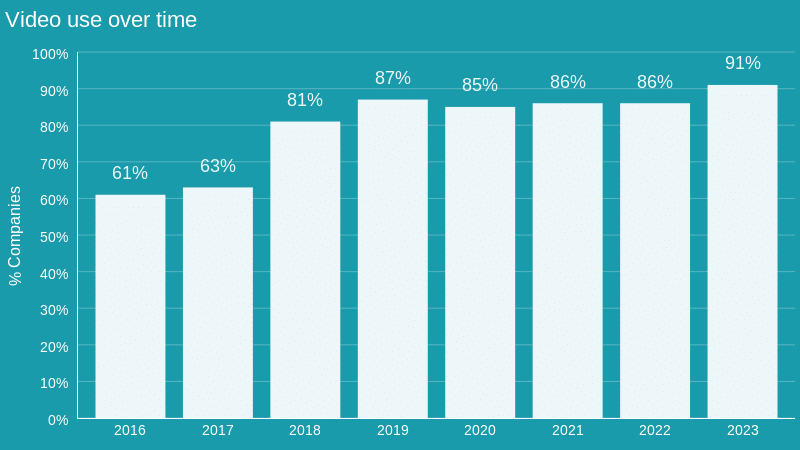
Video has become a crucial element in digital marketing, transforming how companies engage with their audience. Incorporating video into your content marketing strategy is essential to stay competitive in today's market.
The Impact of Video Marketing
Video is utilized by 91% of companies for marketing purposes, making it a widely adopted tool. Moreover, videos are twice as likely to be shared compared to other forms of content.
For 94% of marketers, video has enhanced the overall customer experience, with 87% reporting a positive return on investment. Additionally, the average person spends 18 hours per week watching videos on mobile devices, highlighting the popularity and effectiveness of video content.
Furthermore, incorporating video on your landing page can boost conversion rates by up to 80%, showcasing the power of video in driving consumer action.
Key Video Marketing Statistics
1. By 2023, 91% of companies are projected to utilize video marketing as a fundamental tool, reflecting the growing importance of video content in the digital landscape.
2. The number of video uploads has surged by 263.4% over the last 5 years, driven by consumer demand for more video content online from brands.

3. 52% of companies leverage videos to educate their audience, demonstrating the value of explainer and tutorial videos in conveying product information.
4. Videos are twice as likely to be shared as any other content type, emphasizing their role in boosting sales, brand awareness, and customer trust.
5. As of 2023, 92% of marketers consider videos an integral part of their strategy, contributing to an 86% increase in website traffic.
Video Marketing: Benefits
6. Video plays a significant role in the marketing strategies of 60% of marketers, with 84% reporting success in their video marketing endeavors.
7. Social media videos have proven to be effective, enabling marketers to reach new audiences and acquire new customers.
8. 94% of marketers have observed an improvement in customers' product knowledge through videos, with 72% of consumers expressing a preference for learning about products through video.

9. 87% of marketers believe that video yields a positive return on investment, while also increasing user engagement on websites.
Video Marketing Statistics About Your Audience
10. 96% of consumers watch explainer videos to learn more about products or services, aiding in better understanding a company's values.
11. The average person watches 18 hours of video per week, presenting an opportunity to engage audiences with high-quality video content.
12. 80% of people prefer video over written text, indicating a strong preference for video content consumption.
Video Marketing Channels
15. YouTube boasts over 2.5 billion active users, making it a prominent platform for video content consumption.
16. TikTok is favored by millennials, with American users spending an average of 46 minutes per day on the platform.

17. Instagram Stories ads have a high engagement rate, with 70% of users swiping to visit websites or make purchases.
18. Sponsored Instagram videos generate more comments than photos, demonstrating the effectiveness of video content on social media.
19. LinkedIn users are more likely to share video posts, with live-streams garnering significant engagement compared to published videos.
Video Marketing Best Practices
20. 81% of marketers believe that videos with music perform better, while 66% see value in using voiceovers to enhance video performance.
21. 90% of mobile users consume video content, highlighting the importance of optimizing video for mobile viewing.
22. User-generated content influences buying decisions for 79% of consumers, with brand videos driving purchase intent for 84% of viewers.

23. Videos with captions can boost conversion rates by up to 80% and are preferred by 64% of marketers for their effectiveness.
Perfect Content Marketing Strategy Today
These video marketing statistics underscore the significance of video in engaging audiences and generating leads. Understanding the power of video content allows you to deliver compelling messages to your audience effectively.
Ready to create high-quality video content? Consistency is key to success. Get started today by exploring our weekly blog service or scheduling a consultation to learn more about maximizing your video marketing efforts.
Frequently Asked Questions
What are 3 examples in internet marketing?
Internet Marketing encompasses all activities online that are designed to promote products or services. Internet marketing encompasses email marketing, social networking, search engine optimization, pay-per click advertising (PPC), website design, and pay-per view.
Important to remember that these terms do NOT necessarily mean you will have to spend any money to make money. There are many methods to generate income, and you don't have to spend any cash. The better the return on your investment in each method, however, is the greater the potential for income.
Email marketing is one of the most effective forms of internet marketing. This involves sending out emails to potential customers, informing them about your business and its latest offers.
Social Media Marketing is another popular way to advertise. Users can interact with family and friends on social media sites such LinkedIn, Twitter and Facebook. These sites provide businesses an excellent way to communicate with their clients, increase awareness and build trust in their products or service.
Search Engine Optimization (SEO), is a technique that improves the visibility of websites in major search engines. Webmasters can increase their site's traffic by improving the quality and quantity relevant backlinks.
Website design is the art of creating a website that is attractive and functional. Website designers determine the style and layout of a website. Website designers ensure that websites meet accessibility standards and comply with technical specifications.
Pay Per Click Advertising (PPC) is advertising where advertisers bid on keywords related to their products or services. Advertisers pay when someone clicks on their ad. PPC ads appear on search results pages at the top or bottom.
What are the 4 types of marketing?
Marketing is broken down into four main categories: Direct Mail Marketing and Traditional Advertising. Public Relations is also included. Digital Marketing falls under the umbrella of digital marketing. Each goal has a different purpose and should each be used for its intended purpose. This will allow you to combine them and reach your goals.
What is an example of search engine marketing?
Search Engine Marketing (SEM), is an essential component of digital marketing. SEM includes pay-per-click advertising, sponsored links, display ads, paid inclusion, search engine optimization (SEO), social media marketing, video marketing, mobile advertising, etc.
Statistics
- A poll earlier this year found that 14% of older Gen Z's had bought an item in the previous six months based on an influencer's recommendation. (influencermarketinghub.com)
- In 2017, 34% of marketers cited co-branding as the most effective way to increase the number of email subscribers. (influencermarketinghub.com)
- 81% of brands employ affiliate marketing, and eCommerce sites are particularly good candidates. (blog.hubspot.com)
- Companies that use personalization are seeing revenue increases ranging from 6-10%. (blog.hubspot.com)
- According to statistics, 60% of online shoppers worldwide actively search for coupons before purchasing from a virtual shop. (influencermarketinghub.com)
External Links
neilpatel.com
statista.com
hubspot.com
blog.hubspot.com
How To
Six Types Of Ecommerce Marketing
How can I market my eCommerce shop?
Ecommerce marketing is one the most difficult marketing tasks. It is important to understand the buying behavior of your customer and how they interact in your products and services. This knowledge will enable you to develop a strategy that helps you reach your goals.
There are six types to eCommerce marketing strategies.
- Product Strategy – This is the first step in determining the type of product that you want to sell online. There are three major categories: physical goods (things), virtual goods (services) and membership sites. Once you have decided on the category you want to work in, you will need to decide if you are going to sell wholesale or retail. Wholesale pricing means that you set the price at which your products are sold, while retail pricing means that customers pay directly for your products.
- Pricing Strategy – Next, determine the amount you wish to make selling your products. You should consider profit margins, competition, shipping costs, taxes, etc. When determining your pricing strategy, you should remember two ways to increase profits: lower your cost per sale and/or increase your sales volume.
- Promotion Strategy – This is the fun part! Your business needs a promotion plan that is most effective. One strategy is to offer free shipping and special discounts. Try brainstorming new ideas for promotional items if you don’t have any.
- Shipping Strategy – After you've figured out how to promote your products, you need to think about how you will get them to people. You can ship via USPS or FedEx. Do you prefer to use a fulfillment centre or are you able to do everything yourself?
- Merchandise Management System (MSMS) – This software helps you track inventory, manage orders, fulfill orders, communicate with suppliers, and monitor orders. You have many options depending on your budget and preference.
- Customer Service Strategy. Finally, you will need to devise a customer services strategy that is both effective and profitable for your business. Is your business going to offer email or phone support? Customers can contact you via live chat, social media or snail mail.
————————————————————————————————————————————–
By: 6695
Title: Unlock the Power of Video Marketing: Essential Statistics and Best Practices
Sourced From: internetlib.org/cant-miss-list-of-video-marketing-statistics/
Published Date: 5/1/2023 5:38:40 PM
